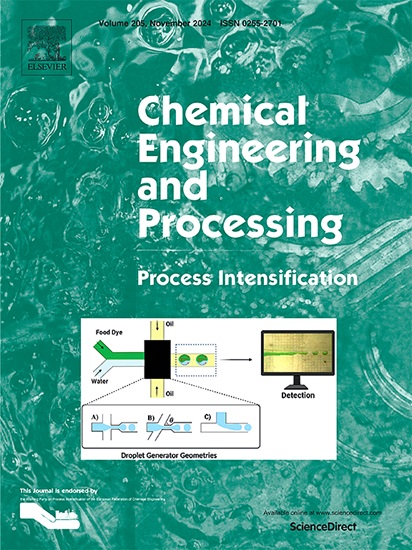Comparative performance assessment of direct contact membrane distillation with and without localized heating
IF 3.8
3区 工程技术
Q3 ENERGY & FUELS
Chemical Engineering and Processing - Process Intensification
Pub Date : 2025-02-01
DOI:10.1016/j.cep.2024.110133
引用次数: 0
Abstract
In the present study, a comprehensive investigation of direct contact membrane distillation with and without localized heating using an effectiveness-number of transfer units (ε-NTU) approach is presented. In addition, the effect of various operating parameters on DCMD performance has been studied. It can be inferred from the analysis that feed solution temperature, membrane porosity, pore diameter and thickness of membrane are the prime influential parameters in determining DCMD performance in terms of distillate flux, gain output ratio (GOR), specific energy consumption (SEC) and overall efficiency. An 80 % increase in feed temperature has resulted increase in permeate flux from 3.1 kg/m2-h to 23.3 kg/m2-h in without localized heating case and from 15.8 kg/m2-h to 73.2 kg/m2-h with localized heating configuration. However, the inclusion of localized heating has increased the distillate flux 2.13 times at 90 °C feed temperature. Furthermore, by increasing the membrane porosity by 50 %, the distillate flux is enhanced from 3.1 kg/m2-h to 11.37 kg/m2-h and from 15.8 kg/m2-h to 57.64 kg/m2-h in the cases of no localized heating and with localized heating respectively. Additionally, the results of the mathematical model suggest a design and operating framework for optimum DCMD performance to minimize temperature and concentration polarization.

求助全文
约1分钟内获得全文
求助全文
来源期刊
CiteScore
7.80
自引率
9.30%
发文量
408
审稿时长
49 days
期刊介绍:
Chemical Engineering and Processing: Process Intensification is intended for practicing researchers in industry and academia, working in the field of Process Engineering and related to the subject of Process Intensification.Articles published in the Journal demonstrate how novel discoveries, developments and theories in the field of Process Engineering and in particular Process Intensification may be used for analysis and design of innovative equipment and processing methods with substantially improved sustainability, efficiency and environmental performance.

 求助内容:
求助内容: 应助结果提醒方式:
应助结果提醒方式:


